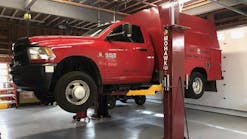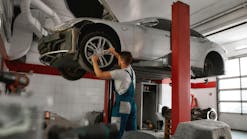By now most people have heard about or seen video footage showing driverless Google cars navigating highways and byways. The concept is nothing short of revolutionary and well on its way to making headway into mainstream markets.
Autonomous vehicles and heavy equipment for military and industrial applications work on the same basic principles, typically providing options for either fully automated or manual operation.
Autonomous engineering leverages technology to mimic five senses
Designed to be faster and more agile than an operator relying on his five senses, unmanned vehicles and equipment are quickly gaining traction in the military, agricultural and commercial sectors. Design engineers are tasked with developing and specifying the right blend of technologies to most effectively do so.
Leveraging the mechatronic equivalents of vision, hearing, smell, taste and touch, autonomous vehicles basically mimic the complex network of physiological sensory input and responses a trained driver, operator or pilot displays when manning a vehicle.
Sight is arguably the sense humans rely most heavily on to survey and respond to surroundings. Not surprisingly, surveillance and positioning cameras have proliferated in unmanned vehicles. In the absence of sensors, cameras provide limited information. A combination of cameras and network of sensors can provide not only sight but also the vast majority of input otherwise derived via an operator's senses.
Increasingly, passenger and commercial vehicles come standard equipped with GPS. While the use of multiple cameras to create a full 360 degree view is still unique to autonomous vehicles, single mounted cameras are becoming ubiquitous in police cars and some passenger car models, as well as many commercial vehicles.
In conjunction with cameras and GPS providing points of reference to other objects, sensors enable perception of motion, obstacles and terrain changes that, in turn, inform the movement and interactions between a vehicle and its environment.
Whether on a passenger car or agricultural equipment, sensors detect not only movement and information an operator would otherwise detect, but they also provide valuable temperature, pressure and other data that otherwise requires manual gauging and monitoring.
As autonomous vehicle sectors advance, the use of multiple cameras will become more commonplace in all of these sectors, with a commensurate increase in the number of sensors—as well as data speed.
As data input devices increase, so too do the engineering challenges of processing and simultaneously translating high-speed digital input from multiple cameras and perhaps 40-50 sensors and formulating logical responses and movements with precision accuracy.
Overcoming barriers with proven robust electronic components
Autonomous vehicles leverage a broad array of technologies to enable GPS, cameras and sensors to serve as the system brain. The electronic components that serve as a foundation for autonomous vehicles include rugged, sealed, high-speed interconnects that can handle vibration and extreme temperatures.
Many of today's autonomous vehicles utilize smart antennas providing a powerful combination of quad band, GSM, Bluetooth and Wi-Fi technologies in a single antenna. Equipped with Ethernet switches, autonomous vehicles can not only process but also transmit enormous amounts of high-speed data to a remote operator or centralized control location.
Conversely, Ethernet switches enable a remote operator to monitor a machine's progress and, if need be, assume manual control. Just as a driver continually scans left and right, the remote operator can do so via real-time video. High-speed ruggedized flex cable provides connections within autonomous vehicles that enable data volume and speed and precision movement responses.
While robust and proven technologies are already being leveraged in unmanned vehicles for military, agricultural and commercial markets, price remains a barrier in some industry sectors.
Not unlike early mobile phone designs that entered the market at a price point well above most per capita means, autonomous vehicles have heretofore found niches primarily in bigger budget operations. Despite the availability of components, networks, computations, and controls, any vehicular technology?especially if used in commercial applications? generally has a lengthy development cycle before being deployed into the field.
It's not unusual for prototypes testing, and other requirements to take several years, unlike cellular phones and other consumer devices that may be developed and released within the same year. Lengthy development cycles can drive up pre-production costs.
In a slow economy, it's not unusual for commercial operations to defer capital equipment purchases or choose lower tier models when replacing outdated or broken equipment. So, the economy will also play a role in the speed of adoption of autonomous vehicles and equipment. The military has long invested in leading technologies and well knows the benefits of autonomous vehicles that agricultural and other private sectors are only beginning to recognize.
Autonomous technologies enable a more strategic work approach
Ruggedized unmanned bots and vehicles are increasingly used in dangerous bomb detection and mining operations. Unmanned aerial vehicles (UAVs) or drones have recently made headlines for their use in surveillance and military operations.
Autonomous vehicles afford a level of safety in military and other operations that can't be achieved in manned operations. Some industry-specific applications might include:
- Military, public safety and disaster assistance. Smaller versions of military concept UAVs are ideal for communities and police departments as an alternative to manned cars or piloted helicopters for routine patrols, traffic control, or even high-speed chases. Agile UAVs can cover more miles, more quickly, than boots on the street or even patrol cars, while streaming digital video to a central command post. UAVs can serve as tools for municipalities for crowd or crime control, even as first responders providing relief and assistance in the aftermath of hurricanes, floods and other natural disasters. Autonomous vehicles can be a lifeline to deliver disaster relief, remove debris, and conduct emergency rescue operations in unsecured areas deemed too dangerous for emergency or construction vehicles to navigate.
- Agricultural. In agricultural applications, autonomous vehicles can vastly improve productivity and reduce manpower required during planting and harvest seasons. Unmanned robo-mowers and turf mowers are already hard at work on farms and golf courses. A large acreage farm can have multiple autonomous vehicles operating simultaneously, while the owner or manager works in tandem or provides oversight. An agricultural setting can require an incredibly minute level of GPS accuracy perhaps within a half inch to safely and efficiently navigate field rows. Concurrently, the same unmanned tractor might be scanning for weeds, while also monitoring temperature, pressure and fuel levels. In addition to requiring ruggedly constructed cameras, sensors and wireless connectivity, these aggregate device inputs quickly add up to enormous high-speed gigabits of data to process and analyze in real time and convey via a network to a remote farm manager.
- Commercial. In commercial operations, such as heavy and off-road construction and mining, autonomous vehicles can traverse tough terrains with poor light or air quality that might otherwise be inaccessible or dangerous to workers. With the right communication protocols, a manager or supervisor can operate multiple autonomous machines and oversee scheduling from a laptop computer or even a mobile device, when a job requires remote access, with real-time access to the machine's control panel and progress. Advance warnings essentially "phone home" to alert the manager when a vehicle may need servicing or refueling. Rather than returning to an equipment corral or barn, a refueling vehicle can be summoned to prevent lengthy work interruptions.
In construction, agriculture and other tight margin operations, autonomous vehicles can bridge the difference between loss and profitability. For operations with tight margins there is typically a relatively short timeframe in which the operator must accomplish the bulk of work—thereby yielding the most money.
Autonomous equipment can operate around the clock to produce a higher yield than manned machines. A farmer might use unmanned equipment to plant, cultivate and harvest a crop—and improve the health of the crop through selective identification of insects or weeds requiring spraying, rather than unnecessarily blanketing large parcels.
Equipped with GPS for precision movement, autonomous vehicles can also prevent tampering and theft of capital equipment and can even be programmed to remain within certain perimeters. If autonomous equipment exits that perimeter for any reason, an alarm alerts the operator to a security breach, so the breach can be reported and the equipment retrieved promptly.
Autonomous vehicles and heavy equipment offer almost limitless possibilities as a transformative force globally. As with any emerging technology, the cost curve for autonomous vehicles will continue to trend downward with commercialization, especially as potential users become more aware of the productivity, efficiency, safety, and other benefits autonomous vehicles can deliver.
Rugged and reliable embedded systems, components and connectors already exist to help make autonomous technologies more practical and affordable, which will fuel expansion—and the military, commercial, and agricultural sectors will continue to lead in that charge.

